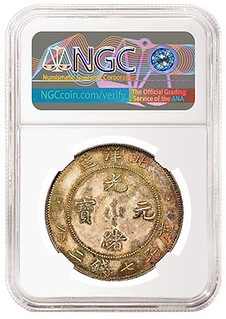
PREV ARTICLE
NEXT ARTICLE
FULL ISSUE
PREV FULL ISSUE
CHINESE SPECIMEN SILVER COINS OFFEREDAn article elsewhere in this issue highlights lots in the upcoming Stephen Album Rare Coins Auction 38. This article from NGC discusses an interesting pair of specimen coins in the sale. -Editor
Specimens are coins struck with special care to accentuate the strike and protect their surfaces. While they don’t quite meet the criteria to be called Proof, Specimens are clearly distinct from circulation strikes. Both of these Specimen coins have exceptional surfaces, strong strikes and amazing original toning. No Specimens or Proofs of this issue were known prior to the discovery of these pieces. They are pedigreed to Richard Bagge, who was Consul-General for Sweden and worked in Shanghai circa 1906. His son, Ragnvald Richardson Bagge (1903-1991) was a Swedish diplomat as well, and this set was a part of his estate. The Peiyang mint began striking silver dollars again in 1903 after a three-year hiatus due to the Boxer Rebellion. It is quite possible that these coins were struck for dignitaries to celebrate the reopening of the mint. Regardless of the precise reason for their striking, the coins were clearly specially struck and merit the prestigious Specimen designation. Both coins were well struck from the same pair of very early die-state dies. The coins indicate a complete lack of die fatigue or erosion, which is frequently seen in the denticles on circulation issues. The rims are also much better formed than those on business strikes, and the dragons are completely struck up, as are the beaded circles on the opposite side of each coin. Also notable is the complete lack of “ghosting” on the reverse, which shows how early the die state is. Ghosting occurs after many planchets are struck and a faint shadow of the dragon will begin to show on the reverse due to the extreme pressures of minting. Lastly, the coins also have extensive die polish and circular die lines that surround the devices on both sides. The lines are all crisp and complete — as opposed to later strikes, which have less-sharp lines that fade in certain areas. The coins are extremely well-preserved. Chinese silver dollars of this era typically have numerous bag marks and wear from handling, neither of which are evident on these coins. This lack of damage shows that they were carefully handled from the time they were struck. The coins’ well-established pedigree goes back to just three to seven years after they were struck. The toning patterns are indicative of a set meant to display both the obverse and reverse of the coins at the same time. Apparently, one coin was dragon side up and the other was dragon side down in a presentation case. As a result, the obverse toning pattern of one matches the reverse toning pattern of the other. The depth and originality of the toning indicates that the set was likely stored in the same case for decades.
To read the complete article, see:

Wayne Homren, Editor The Numismatic Bibliomania Society is a non-profit organization promoting numismatic literature. See our web site at coinbooks.org. To submit items for publication in The E-Sylum, write to the Editor at this address: whomren@gmail.com To subscribe go to: https://my.binhost.com/lists/listinfo/esylum All Rights Reserved. NBS Home Page Contact the NBS webmaster 
|
